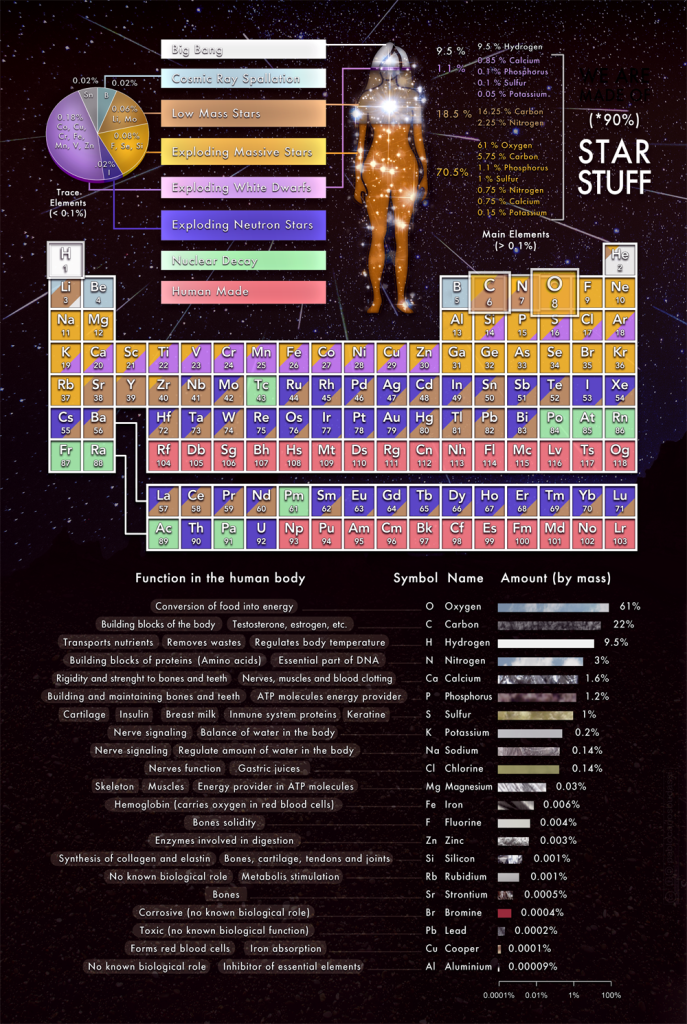Introduction

Have you ever asked yourself the questions, “Where did I come from? Where did it all come from?” If so, you’re not alone.
How should one go about answering these questions? Some philosophers have spent their entire careers trying to clarify what we even mean when we ask these questions (it is not always clear). You may be wondering about yourself as an individual and your immediate context when you ask these questions. We can also branch out from ourselves and what we perceive in our immediate vicinity. From there, we may begin to see incredible similarities and differences.
You are reading this text as a living, breathing human being, and so there is a lot you have in common with the other billions of living, breathing human beings on this planet. We can ask, as is done in the image above, what makes you up as a living, breathing human being. As far as science can ascertain, what makes us human is a particular arrangement of basic building blocks of biology, chemistry, and physics. In particular, there are certain amounts and arrangements of atoms that are unique to humans and, more broadly, the living things on planet Earth.
Where then did these atoms come from? The answer, also shown in the image above, is that atoms as we know them to exist originated in a variety of astrophysical scenarios that range from the peculiar to the extreme. In fact, the atoms that make us up are very stable and are only seen to change form under very unique circumstances. In contrast, in the vastness of space and over the eons, many opportunities have arisen for atoms to change form. There was even a moment in the distant past where atoms themselves first came into being as it was not possible for them to exist at the start of the universe, which was incredibly hot and dense.

Here on Earth, life exists in an amazing array of forms. Only in the last few decades have we become increasingly appreciative of the fact that most of the diversity of Earth’s life is very different from us as human beings. Indeed, most of the things we’ve recognized as being “alive” are much more similar to human beings than the vast majority of organisms that we now recognize as living. Bacteria form the largest collection of living things on our planet. If an alien scientist were to study the Earth and ask for a random specimen of living things, chances are a bacteria would be the sample.
But just because life developed on Earth in the way we see it, this does not mean this is the way life developed elsewhere in the universe. We have no real way to know one way or another. Life has never been discovered beyond the confines of our home. Nevertheless, new opportunities abound in the discovery of possibilities for other locations where life might be. Over the last thirty years, thousands of planets beyond our Solar System (known as exoplanets) have been discovered. Many of these exoplanets share similar characteristics to Earth. We don’t know whether sharing characteristics similar to Earth is necessary for life to exist, but lacking any other information about where to look, many scientists think that this is a good place to start.

In this text, we will consider those options and see how far we’ve gotten so far in our voyage of discovery. Maybe you will think of ways to take us further and discover more. Are we alone in this vast universe, or is life out there waiting for us to discover it? We can only guess as to what the answer to this question is, but we can have a lot of fun learning about the question anyway!
the smallest unit of stable matter which makes up the natural world. An atoms is composed of a positively charged nucleus (made of protons and neutrons) surrounded by an electron cloud.
The investigation of the way the nature functions in contexts beyond the Earth. Often interchangeable with the term "astronomy".
an event that occurred 13.8 billion years ago when the universe began expanding from an extremely hot and dense primordial state
The most common form of life on Earth, they form a "domain" that encompassed most of the diversity of genetic material in our biosphere.
Objects in our local planetary system that are gravitationally bound, including the Sun, the eight planets and their moons, asteroids, comets, and other debris.
A planet beyond our Solar System.
